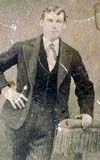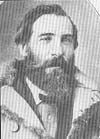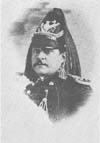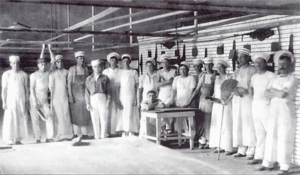 William H. Gilbert (left) was born on November 11, 1851, in Philadelphia, Pennsylvania. He was a Corporal in Company L who was killed with Custer’s Column during the Battle of the Little Bighorn.
William H. Gilbert (left) was born on November 11, 1851, in Philadelphia, Pennsylvania. He was a Corporal in Company L who was killed with Custer’s Column during the Battle of the Little Bighorn.
 Stanislas Roy (right) was born in France on November 12, 1846. He enlisted in the Seventh Cavalry in 1869 and served on both the Yellowstone and Black Hills expeditions. He later served as a Corporal in Company A in the valley and hilltop fights at Little Bighorn. He was awarded the Medal of Honor on October 5, 1878, for bringing water to the wounded during the battle. He made two trips to the river under heavy fire.
Stanislas Roy (right) was born in France on November 12, 1846. He enlisted in the Seventh Cavalry in 1869 and served on both the Yellowstone and Black Hills expeditions. He later served as a Corporal in Company A in the valley and hilltop fights at Little Bighorn. He was awarded the Medal of Honor on October 5, 1878, for bringing water to the wounded during the battle. He made two trips to the river under heavy fire.
William Sadler died of diabetes on November 12, 1921, in Linton, North Dakota, and was buried in the Linton Cemetery there. He was a Private in Company D who was not present due to detached service at Powder River.
 Patrick Coakley, (left) died at the Soldiers’ Home in Washington, D.C., on November 13, 1881, and was buried in the National Cemetery there. He was a Private in Company K who was not present at the battle due to detached service.
Patrick Coakley, (left) died at the Soldiers’ Home in Washington, D.C., on November 13, 1881, and was buried in the National Cemetery there. He was a Private in Company K who was not present at the battle due to detached service.
Thomas H. Rush died on November 13, 1905, in Elmhurst, Alameda County, California. He was a Sergeant in Company D who was not present at the battle because he was hospitalized at Fort Abraham Lincoln, Dakota Territory.
William C. Slaper died on November 13, 1931, in Sawtelle, California, and was buried in the Los Angeles National Cemetery. He was  a Private in Company M who participated in the valley and hilltop fights.
a Private in Company M who participated in the valley and hilltop fights.
Frederic Francis Girard (right) was born on November 14, 1829, in St. Louis, St. Louis County, Missouri. On November 15, 1877, he married his second wife, Ella Scarborough Waddell. He had previously been married to a Piegan Indian. He was an Interpreter on the Quartermaster staff who went missing during the valley fight on June 25, 1876. He rejoined the soldiers on Reno Hill on June 26.
 Edward Rood (left) was born in Tioga County, New York, on November 14, 1847. He was a Private in Company E who was killed in the battle.
Edward Rood (left) was born in Tioga County, New York, on November 14, 1847. He was a Private in Company E who was killed in the battle.
 Marcus Albert Reno (right) was born on November 15, 1834, in Carrollton, Illinois. Entire books have been written about Major Reno because he played a significant and controversial role in the battle.
Marcus Albert Reno (right) was born on November 15, 1834, in Carrollton, Illinois. Entire books have been written about Major Reno because he played a significant and controversial role in the battle.
Frank Volkenstine was born on November 15, 1844, in Birmingham, Michigan. He was a Private in Company M who was not present at the battle. He had been dishonorably discharged on May 31, 1876, in Fort Wayne, Michigan.
Markus Weiss died on November 15, 1879, at Fort Meade in the Dakota Territory and was buried in the Fort Meade National Cemetery in Sturgis, South Dakota. He died of a compound fracture of his neck that resulted from a cave-in of a gravel bank. He was a Private in Company G who participated in the valley and hilltop fights.
James J. Galvan, who was also known as Michael J. Miller, was born in Liverpool, England, on November 16, 1848. He was a Private in Company L who was killed in the battle.
Hugh McGonigle died on November 16, 1916, in Washington, D.C., and was buried at the Soldiers’ Home National Cemetery there. He was a Private in Company G who fought in the valley and hilltop fights.


